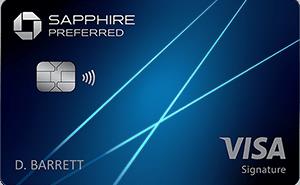Updated On:
June 11, 2020
• 3 Minute Read
You just found a great credit card that offers an awesome signup bonus, like cash back or thousands of free miles. The only downside? You have to spend thousands within the first three months of opening an account to claim it.
For example, the Chase Sapphire Preferred® Card You can earn 60,000 bonus points after you spend $4,000 on purchases in the first 3 months from account opening. That’s a significant reward, but the $4,000 minimum requirement might sound steep. You will also enjoy benefits such as 5x on travel purchased through Chase Travel℠, 3x on dining, select streaming services and online groceries, 2x on all other travel purchases, 1x on all other purchases, $50 Annual Chase Travel Hotel Credit, plus more.
While it may feel like you have to go on a mega shopping spree to qualify for the bonus, there’s no need to go into debt to meet the minimum spending requirement. In fact, there are six easy ways to meet the requirement without going broke.
1. Pay your rent or mortgage with your credit card
You can quickly meet the minimum spending requirement on most credit cards by paying your rent or your mortgage payment with credit. The average rent payment is $1,405 each month, so in three months, you’ll have spent over $4,000 using your credit card. That’s enough to get you most of the way.
Just be aware that some rental or mortgage companies do charge a convenience fee for using a credit card, so make sure you weigh that cost against the potential bonus.

2. Charge your bills
If you have recurring bills, like your utilities, car insurance, or even your Netflix subscription, charge everything to your credit card. These are expenses you’d have to pay anyway, so you might as well use your credit card. These utility payments can add up quickly, helping you reach the minimum requirement.
3. Get reimbursed for business expenses
If you travel or have business meetings, use your personal credit card to pay for business expenses, then submit your receipts for reimbursement from your company. It’s a great way to rack up extra charges without digging yourself into debt; plus, you’ll also earn some cash back rewards, too.
4. Purchase gift cards
If there’s certain retailers you always shop at, purchase discounted gift cards. You can buy gift cards for a fraction of their actual value on sites like Raise.com or Gift Card Spread — we found a gift card for H&M that was 29% off — helping you save money while charging them to your credit card. Then, just use your gift cards to make your normal purchases.

5. Pick up the tab
When you’re out with friends, offer to put the check on your credit card. Then, ask your friends to send you the money for their portion of the bill via Venmo. That way, you only pay for your portion, but get credit for the full amount toward the minimum spending requirement.
6. Use your card to buy groceries and gas
Finally, use your credit card for other routine expenses, like filling up your gas tank or purchasing your groceries for the week. These are normal expenses you would have to pay for anyway, so it’s an easy and painless way to up your spending without damaging your bottom line.
Choosing a credit card

When you’re searching for the perfect credit card, make sure you pay attention to all the rewards. One of our favorites? Check out the Chase Sapphire Preferred® Card. You will enjoy new benefits such as 5x on travel purchased through Chase Travel℠, 3x on dining, select streaming services and online groceries, 2x on all other travel purchases, 1x on all other purchases, $50 Annual Chase Travel Hotel Credit, plus more. And with that intro bonus, you will be well on your way to free travel, getting paid back for your everyday purchases and more!
Editorial Disclaimer: Information in these articles is brought to you by CreditSoup. Banks, issuers, and credit card companies mentioned in the articles do not endorse or guarantee, and are not responsible for, the contents of the articles. The information is accurate to the best of our knowledge when posted; however, all credit card information is presented without warranty. Please check the issuer’s website for the most current information.